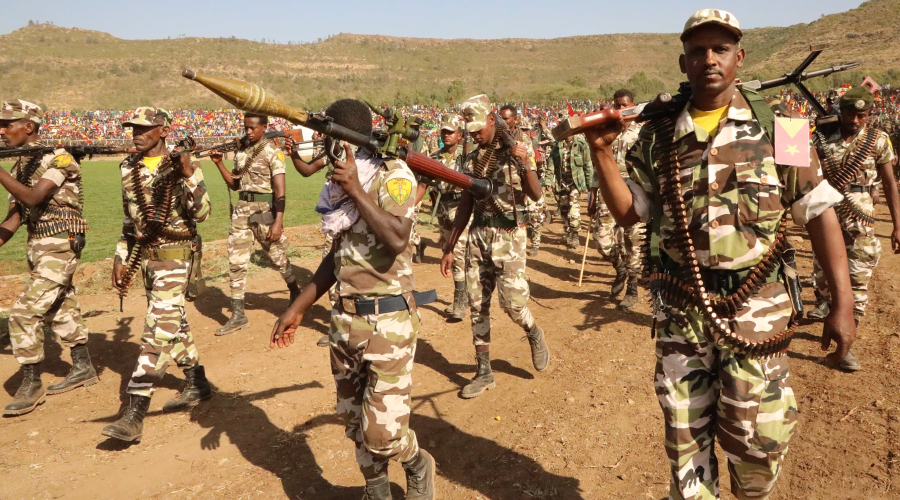Despite Cease-Fire in Tigray, No End in Sight for Conflict
The Ethiopian government declared a truce in June, but fighting has continued and the humanitarian crisis has worsened.

Published by The Lawfare Institute
in Cooperation With

Editor’s Note: The bitter war between Tigrayan forces and the Ethiopian government has claimed thousands of lives. In late June, a ray of hope appeared when the Ethiopian government declared a cease-fire, but this quickly vanished as the violence continued. Hilary Matfess of the Josef Korbel School of International Studies at the University of Denver examines the latest fighting and assesses why there is little hope the fighting will end soon.
Daniel Byman
***
On June 28, the Ethiopian government declared a unilateral cease-fire in the war in Tigray. There was optimism that the cease-fire would help draw down the conflict, which erupted in November 2020.
The fighting followed a dispute over the constitutional mandate of the current Ethiopian administration after it delayed elections amid the coronavirus pandemic and a broader falling out between the Tigray People’s Liberation Front (TPLF, formerly the dominant political party in the country’s political system) and Prime Minister Abiy Ahmed. (Throughout this article, the term “Tigrayan forces” is used to refer to the Tigrayan belligerents in the conflict; they are also referred to as the Tigray People’s Liberation Front in direct quotes.) The conflict quickly drew in other armed groupsa, including Eritrean and Amharan forces as well as ethnic militias. While the full extent of the fatalities is uncertain, it is clear that the conflict involves not only armed belligerents but also civilians who have found themselves in the crosshairs. Thousands of people have been killed and roughly 2 million have been displaced since the outbreak of violence; furthermore, there have been reports of ethnically targeted violence and sexual violence used as a weapon of war.
There have been calls for independent investigations into the reported human rights abuses as well as suggestions for a national dialogue to address the political drivers of the violence—objectives that would be easier to achieve in the context of legitimate commitment to a cease-fire. At the very least, there was hope that the cease-fire would be accompanied by greater humanitarian access in Tigray, where an estimated 5 million people are in need of humanitarian aid.
Yet, in the weeks since the cease-fire was declared, it has become clear that the cease-fire did not lay the foundation for conflict resolution. Fighting has continued in the region, and armed forces from the country’s other ethno-regional states have been mobilized to contribute to the fight alongside the regime. In recent days, the Ethiopian prime minister urged all Ethiopian civilians to join the fight, encouraging those who were eligible to “join the Defense Forces, Special Forces and militias and show your patriotism,” and asserting that “every Ethiopian must work closely with the security forces in being the eyes and ears of the country in order to track down and expose spies and agents of the terrorist TPLF.” The federal government’s reliance on militias in this fight could produce even more volatility.
Some observers have raised concerns about the federal government’s rhetoric in the weeks following the cease-fire, suggesting that it may encourage ethnically targeted violence. iIn addition to the recent exhortations for Ethiopians to join the fight, the prime minister has “used words such as ‘weeds,’ ‘cancer’ and ‘disease’ to describe the Tigray People’s Liberation Front (TPLF).”
The cease-fire declaration may well be regarded in hindsight as a turning point for the war in Tigray—but as a harbinger of escalation rather than peace-building. Despite the surge in optimism earlier this summer, the conflict now seems as intractable as ever and the prospects of a negotiated settlement appear faint.
A Nominal Cease-Fire
There are competing narratives regarding the events surrounding the announcement of the cease-fire.
The federal government more or less declared victory in late November, though the war has continued to drag on since then. The federal government described the recent removal of its troops from Mekelle as a “strategic withdrawal.” The federal government also suggested that the cease-fire was adopted to avert a humanitarian catastrophe and “will enable farmers to till their land, aid groups to operate without any military movement around and engage with remnants [of Tigray’s former ruling party] who seek peace.”
At the same time, Tigrayan forces’ assert that their entry into the regional capital, Mekelle, prompted the government’s cease-fire announcement and that they “had driven the government out of the city.” After initially appearing to reject the cease-fire (according to one report, the “TPLF dismissed that truce as a joke”), they accepted it “in principle” and issued a statement laying out a set of political demands. These demands included the withdrawal of Eritrean and Amharan forces, investigations into the allegations of brutal violence and war crimes, humanitarian access to the region, and a “transitional arrangement” that has been interpreted to mean the removal of Prime Minister Abiy.
Shots Fired After the Cease-Fire
The cease-fire did not catalyze political negotiations—nor, does it seem, did it ever meaningfully curtail the violence.
In the days following the declaration of the cease-fire, the United Nations and aid groups described “a concerted campaign by government-aligned forces to punish and isolate Tigray, destroying key infrastructure in ways that will complicate the delivery of urgent relief, if not make it impossible.” A particularly significant development was the destruction of a bridge that was critical for the transportation of aid.
Though suggesting openness to a political solution, the Tigrayan forces continued to pursue their military campaign against the federal government and its allies. On June 29, Getachew Reda, a TPLF spokesperson, told the media that “Our primary focus is to degrade enemy fighting capabilities …. So if going to Amhara is what it takes, we will do it, if going to Eritrea is what it takes, we’ll do it." The Tigrayan forces also stated that they would pursue operations pushing west to restore the preconflict border between Amhara and Tigray. Will Davison, the International Crisis Group’s senior Ethiopia analyst, told the Washington Post that “any Tigrayan attempt to remove Amhara control” from areas of western Tigray “would naturally be followed by an attempt to establish a supply line into Sudan, especially as other supply routes are being blocked.”
In the weeks since the cease-fire was announced, the Tigrayan forces have expanded their activities into the neighboring Afar and Amhara regions. In early August, they took control of Lalibela, a UNESCO World Heritage site home to rock-hewn churches. The Agence France-Presse reports that the TPLF has repeatedly said it does not intend to hold territory in Amhara and Afar and instead wants to facilitate aid access and prevent pro-government forces from regrouping.”
Regardless of intent, these activities have placed a considerable burden on civilian populations; reports from early August suggest that 200,000 people living in the Amhara region and more than 50,000 people living in Afar were displaced. An Afar region official also blamed an attack that killed more than 200 internally placed people on Tigrayan forces, though responsibility for the attack and the number of fatalities could not be independently verified by news agencies.
Some of the most troubling pre-existing conflict trends, such as ethnically targeted violence and violence against refugees, continued following the announcement of the cease-fire. Much of the reporting on ethnic violence since the cease-fire announcement has described violence against Tigrayans. One refugee interviewed by the BBC in mid-July claimed that “the Amhara militia are going door to door. If they know you are a Tigrayan they kill or arrest you. ... Anyone who can escape is fleeing.” In early August, international news outlets reported the discovery of mutilated bodies floating down the Tekeze River, downstream from Humera, a town “where authorities and allied fighters from Ethiopia’s Amhara region have been accused by refugees of forcing out local Tigrayans during the war while claiming that western Tigray is their land.” At least some of the dead “had tattoos or facial markings common among Tigrayans.” Additionally, in late July there were also accusations of Tigrayan forces targeting Eritrean refugees in Tigray.
Adjudicating between the competing claims about who is responsible for the violence in the region—and staying abreast of conflict dynamics in Tigray generally—is complicated by the communications blackout across much of the region and the limited humanitarian access.
What Comes Next?
The complex emergency in Tigray is poised to escalate, and there appears to be little will to broker the sort of political settlement necessary to draw down the violence. The array of actors involved in the violence complicates the prospects of a negotiated settlement and introduces a number of distinct political agendas and potential spoilers. This complexity is only growing, with news in recent days that Tigrayan forces are discussing forming an alliance with the Oromo Liberation Army, an insurgent group in Ethiopia’s Oromia region. Meanwhile, the suffering of civilians in the war-affected areas is being compounded by the lack of humanitarian access.
Territorial disputes between Tigray and Amhara may continue to fuel violence in the region. The regions in question, which include fertile farmland, were included in the Tigray region as a part of the constitution adopted in 1995, under the TPLF-led Ethiopian People’s Revolutionary Democratic Front. According to the Voice of America, “the Amhara claim the land was taken from them when the Tigrayan People’s Liberation Front took control of the national government.”
The involvement of other ethno-regional forces in the conflict might not only intensify the violence in the war against the Tigrayan forces, but spur other conflicts as well. Vanda Felbab-Brown argues that “after initially fighting TDF, many of the militias popping up around Ethiopia will turn against the capital, as well as against one another, in their conflicts over resources and power distribution, even though some are likely to accommodate with TDF.”
Another complicating and troubling characteristic of the conflict is the Ethiopian federal government’s skeptical stance toward international humanitarian aid and the credible accusations that the Ethiopian government is using starvation as a weapon. Despite calls from the international community for “unfettered access,” aid groups’ reach is still limited, leaving millions in precarious circumstances. Furthermore, the Foreign Ministry levied serious accusations against the aid sector, claiming that “some aid agencies have been actively engaged in a destructive role. We have also confirmed that they have been using aid as a cover and are arming the rebel groups to prolong the conflicts.” Additionally, the government recently suspended in part or completely the activities of Doctors Without Borders and the Norwegian Refugee Council. In early August, the prime minister reportedly ignored a request to meet with Samantha Power, the head of the U.S. Agency for International Development, while she was visiting the country.
Despite the incredible human toll that this conflict has already exacted and the hope that emerged with the announcement of a cease-fire, the conflict in Ethiopia shows no signs of abating.




